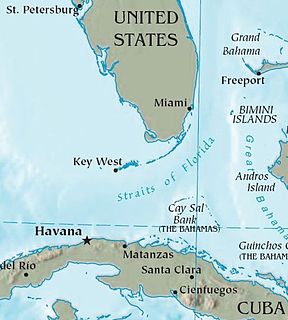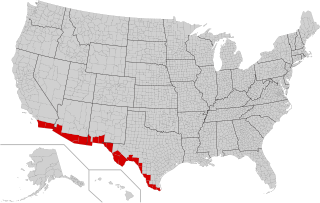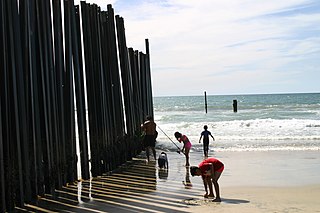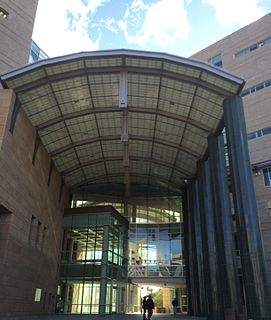Related Research Articles

People smuggling, under US law, is "the facilitation, transportation, attempted transportation or illegal entry of a person or persons across an international border, in violation of one or more countries' laws, either clandestinely or through deception, such as the use of fraudulent documents".
The U.S. Immigration and Customs Enforcement (ICE) is a federal law enforcement agency under the U.S. Department of Homeland Security. ICE's stated mission is to protect the United States from the cross-border crime and illegal immigration that threaten national security and public safety.

The United States Border Patrol (USBP) is the United States Customs and Border Protection's federal law enforcement arm within the United States Department of Homeland Security (DHS). The USBP is the armed and uniformed federal police that secure the borders of the United States by detecting and preventing illegal aliens, terrorists and terrorist weapons from entering the United States, and prevent illegal trafficking of people and contraband.

Migrant deaths along the Mexico–U.S. border occur hundreds of times a year as people attempt to cross into the United States from Mexico illegally. The US Border Patrol reported 294 migrant deaths in the fiscal year 2017, which was lower than in 2016 (322), and any year during the period 2003-2014. Exposure were the leading cause.

The Mexico–United States barrier, also known as the border wall, is a series of vertical barriers along the Mexico–United States border intended to reduce illegal immigration to the United States from Mexico. The barrier is not a continuous structure but a series of obstructions variously classified as "fences" or "walls".

The wet feet, dry feet policy or wet foot, dry foot policy was the name given to a former interpretation of the 1995 revision of the application of the Cuban Adjustment Act of 1966 that essentially says that anyone who emigrated from Cuba and entered the United States would be allowed to pursue residency a year later. Prior to 1995, the U.S. government allowed all Cubans who reached U.S. territorial waters to remain in the U.S. After talks with the Cuban government, the Bill Clinton administration came to an agreement with Cuba that it would stop admitting people intercepted in U.S. waters. For two decades thereafter, any Cuban caught on the waters between the two nations would summarily be returned to Cuba or sent to a third country, while one who made it to shore got a chance to remain in the United States, and later would qualify for expedited "legal permanent resident" status in accordance with the 1966 Act and eventually U.S. citizenship. On January 12, 2017, Barack Obama announced the immediate end of the policy.

The Mexico–United States border is an international border separating Mexico and the United States, extending from the Pacific Ocean in the west to the Gulf of Mexico in the east. The border traverses a variety of terrains, ranging from urban areas to deserts. The Mexico–United States border is the most frequently crossed border in the world, with approximately 350 million documented crossings annually. It is the tenth-longest border between two countries in the world.

A border guard of a country is a national security agency that performs border security, i.e., enforces the security of the country's national borders. Some of the national border guard agencies also perform coast guard and rescue service duties.
Illegal immigration to the United States is the process of migrating into the United States in violation of federal immigration laws. This can include foreign nationals who have entered the United States illegally, as well as those who entered legally but then remained after the expiration of their entry visa or parole documents. Illegal immigration has been a matter of intense debate in the United States since the 1980s.
Operation Gatekeeper was a measure implemented during the Presidency of Bill Clinton by the United States Border Patrol, aimed at halting illegal immigration to the United States at the United States–Mexico border near San Diego, California. According to the INS, the goal of Gatekeeper was "to restore integrity and safety to the nation's busiest border."

Illegal immigration refers to the migration of people into a country in violation of the immigration laws of that country, or the continued residence without the legal right to live in that country. Illegal immigration tends to be financially upward, from poorer to richer countries. Illegal residence in another country creates the risk of detention, deportation, and/or other sanctions.

An open border is a border that enables free movement of people between jurisdictions with few or no restrictions on movement, that is lacking substantive border control. A border may be an open border due to intentional legislation allowing free movement of people across the border, or a border may be an open border due to a lack of legal controls, a lack of adequate enforcement or adequate supervision of the border. An example of the former is the Schengen Agreement between most members of the European Economic Area. An example of the latter has been the border between Bangladesh and India, which is becoming controlled. The term "open borders" applies only to the flow of people, not the flow of goods and services, and only to borders between political jurisdictions, not to mere boundaries of privately owned property.

Illegal entry is the act of foreign nationals arriving in or crossing the borders into a country in violation of its immigration law. Human smuggling is the practice of aiding people in crossing international borders for financial gain, often in large groups. Human smuggling is associated with human trafficking. A human smuggler will facilitate illegal entry into a country for a fee, but on arrival at their destination, the smuggled person is usually free. Trafficking involves physical force, fraud, or deception to obtain and transport people, usually for enslavement or forced prostitution.

Emigration from Mexico is the movement of people from Mexico to other countries. The top destination by far is the United States, by a factor of over 150 to 1 compared to the second most popular destination, Canada.

Colloquially, a coyote is a person who smuggles immigrants across the U.S.–Mexico border. The word "coyote" is a loanword from Mexican Spanish that usually refers to a kind of North American wild dog (Canis latrans).
Human trafficking is the trade of humans, most commonly for the purpose of forced labour, sexual slavery, or commercial sexual exploitation for the trafficker or others. Mexico is a large source, transit, and destination country for victims of human trafficking.

The 2014 American immigration crisis was a surge in unaccompanied children and women from the Northern Triangle of Central America (NTCA) seeking entrance to the United States in 2014. According to U.S. law, an unaccompanied alien child refers to a person under 18 years of age, who has no lawful immigration status in the U.S., and who does not have a legal guardian to provide physical custody and care.

Operation Streamline is a joint initiative of the Department of Homeland Security and Department of Justice in the United States, started in 2005, that adopts a "zero-tolerance" approach to unauthorized border-crossing by criminally prosecuting those perpetrating it. Up to 70 people are tried at the same time, sometimes wearing shackles in the courtroom. Entering without inspection is a misdemeanor, and re-entering after deportation is a felony.

The Trump administration, as continuation of Obama administration policy, has detained migrants attempting to enter the United States at the United States–Mexico border. Government reports from the Department of Homeland Security Office of Inspector General in May 2019 and July 2019 have found that migrants were detained under conditions failing federal standards, featuring prolonged detention, overcrowding, poor hygiene and food standards. Some American citizens were wrongfully detained.
Enforcement with consequences is the policy implemented within the US to help deter the rising tide of immigration that has grown in the US. It is the expansion of policy and consequences for people who choose to enter illegally and subjects them to legal, political and educational debates concerning legality status.
References
- 1 2 3 Guerette, Rob T.; Clarke, Ronald V. (June 2005). "Border Enforcement, Organized Crime, and Deaths of Smuggled Migrants on the United States – Mexico Border". European Journal on Criminal Policy and Research. 11 (2): 159–174. doi:10.1007/s10609-005-6716-z.
- ↑ Horsley, Scott (2016-09-01). "6 Things You Might Not Have Known About Trump's Border Enforcement Plan". NPR.
- ↑ Woodruff, Betsy (2016-09-27). "No, U.S. Immigration and Customs Enforcement Did Not Endorse Trump". The Daily Beast.
- ↑ Cornelius, Wayne A. (December 2001). "Death at the Border: Efficacy and Unintended Consequences of US Immigration Control Policy". Population and Development Review. 27 (4): 661–685. doi:10.1111/j.1728-4457.2001.00661.x.
- ↑ Cornelius, Wayne A.; Salehyan, Idean (June 2007). "Does border enforcement deter unauthorized immigration? The case of Mexican migration to the United States of America". Regulation & Governance. 1 (2): 139–153. doi: 10.1111/j.1748-5991.2007.00007.x .
- ↑ Massey, Douglas S.; Durand, Jorge; Pren, Karen A. (March 2016). "Why Border Enforcement Backfired". American Journal of Sociology. 121 (5): 1557–1600. doi:10.1086/684200. PMC 5049707 . PMID 27721512.
- ↑ Angelucci, Manuela (January 2012). "US Border Enforcement and the Net Flow of Mexican Illegal Migration" (PDF). Economic Development and Cultural Change. 60 (2): 311–357. doi:10.1086/662575. hdl:10419/33619.